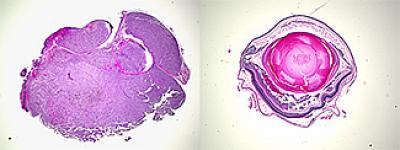Researchers at the University of California, San Diego School of Medicine have identified a therapeutic target for treating the most common form of eye cancer in adults. They have also, in experiments with mice, been able to slow eye tumor growth with an existing FDA-approved drug.
The findings are published online in the May 29 issue of the journal Cancer Cell.
"The beauty of our study is its simplicity," said Kun-Liang Guan, PhD, professor of pharmacology at UC San Diego Moores Cancer Center and co-author of the study. "The genetics of this cancer are very simple and our results have clear implications for therapeutic treatments for the disease."
The researchers looked specifically at uveal melanoma. Uveal collectively refers to parts of the eye, notably the iris, that contain pigment cells. As with melanoma skin cancer, uveal melanoma is a malignancy of these melanin-producing cells.
Approximately 2,000 people in the United States are diagnosed with uveal melanoma each year. If the cancer is restricted to just the eye, the standard treatment is radiation and surgical removal of the eye. But uveal melanoma often spreads to the liver, and determining the metastatic status of the disease can be difficult. In cases of uveal melanoma metastasis, patients typically succumb within two to eight months after diagnosis.

An untreated uveal melanoma tumor (left) covers entire eye of a mouse. A tumor treated with verteporfin (right) is much smaller and much of the structure of the mouse's eye is visible.
(Photo Credit: UC San Diego School of Medicine)
Scientists have long suspected a genetic association with uveal melanoma because one of two gene mutations is present in approximately 70 percent of all tumors. Until this study, however, they had not identified a mechanism that could explain why and how these mutations actually caused tumors.
The work by Guan and colleagues unravels the causal relationship between the genetic mutations and tumor formation, and identifies a molecular pathway along which drugs might counterattack.
The two genes implicated – GNAQ and GNA11 – code for proteins (known as G proteins) that normally function as molecular on-off switches, regulating the passage of information from the outside to the inside of a cell.
In their experiments, the scientists showed that mutations in these genes shift the G proteins to a permanent "on" or active status, which results in over-activation the Yes-associated protein (YAP). The activation of the YAP protein induces uncontrolled cell growth and inhibits cell death, causing malignancies.
Earlier research by other scientists has shown that the drug verteporfin, used to treat abnormal blood vessel formation in the eye, acts on the YAP pathway inhibiting the protein's YAP function.
In experiments with mice, the UC San Diego-led team showed that verteporfin also suppresses the growth of uveal melanoma tumors derived from human tumors.
"We have a cancer that is caused by a very simple genetic mechanism," Guan said. "And we have a drug that works on this mechanism. The clinical applications are very direct."




Comments